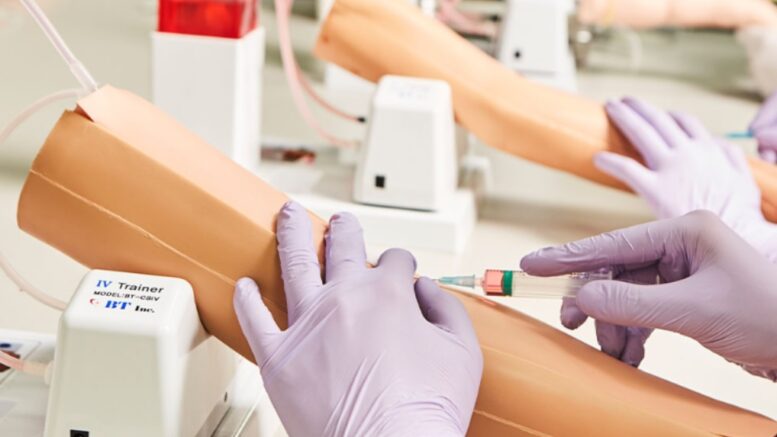To administer injectable medications and make sure they are up to date with the most recent best practices and procedures, all healthcare professionals are required to attend injection administration training. The National Patient Safety Agency demands all practitioners involved in injectable medication administration possess the knowledge, abilities, and attitudes necessary to prepare and administer prescribed medications safely. The Nursing and Midwifery Council (NMC, 2018) also highlight the need for all practitioners to have a suitable level of competence in their abilities.
The practice of unsafe techniques can result in serious negative effects on patients, such as pain, abscesses, and nerve damage, which may give rise to legal action. That said, it’s of extreme importance that healthcare professionals complete Injection Administration training to ensure that they are giving patients the best care possible while avoiding negative outcomes.
What Is Involved in Injection Administration Training
Traditional learning methods like lectures, apprenticeships, and practice-based learning are still used these days to give students fundamental knowledge. But in today’s medical schools, using medically based healthcare simulations has become the norm.
Instead of learning through apprenticeship, medical simulation enables the acquisition of clinical skills through hands-on practice. Thanks to technological advancements, simulation tools have replaced actual patients as a way for trainees to make procedural errors and learn from them without worrying about hurting the patient.
It’s practically impossible for the instructor to confirm whether an injection was given to the proper area when a student injects a human subject or an injection pad. That said, proper simulators can confirm proper tissue placement by using coloured indicator lights and sounds and providing electronic feedback to students and instructors.
Which Injection Training Simulator to Get?
Today’s market offers a wide range of injection training kit options made to give trainees a lifelike experience when practising SC and IM injections. Here are some options that come with many advanced features users would like to have.
Advanced Arm Life/form by Nasco Healthcare
This is one of the best resources for training as it includes starting IVs and “Over the Needle IV” catheters. This arm simulator is straightforward to use, assisting students in learning new techniques without putting patients in danger or exposing themselves to legal liabilities.
There’s great attention to realism in this kit, with many fine details, even down to fingerprints. But what counts most is the lifelike feeling when piercing the needle through the artificial skin and veins. The skin rolls when you palpate the vein, and you can hear the unmistakable “pop” sound the needle makes as it enters the vein.
The antecubital fossa, along the forearm, and on the back of the hand all have veins that can be accessed for venipuncture practice. Practise with intramuscular injections is similarly realistic. A foam pad represents muscle tissue, and bony markers delineate the borders.
Another great thing about this arm simulator is that the skin and veins are replaceable (easy-to-use, full replacement skin kits are available). To improve the life of each skin/vein, consider investing in an aerosol sealant, which is designed to patch holes in the tubing and stop leaks.
This injection simulator includes a Life/form® arm with skin, a carrying case, a teaching guide, one pint of Life/form® blood, needles, 12cc and 3cc syringes, an infusion set, and a blood donor set.

Peripheral IV Training Arm by CAE Medicor
This IV arm is a best-seller. It comes with four veins for practising conducting peripheral IV insertions. To imitate an IV drip and blood flow, two bags are available, one for each arm. A realistic flashback is shown to students who successfully put the catheter to verify placement.
This simulation kit comes with two options: clear tubing so that students can locate vessels solely by palpation and black tubing so that students can see the vascular anatomy before inserting a needle.
The outer layer of the training arm can be replaced to prolong the life of the model and the tubing can also be changed.
Intradermal Injection Simulator Life/form® by Nasco Healthcare
This training tool features a vinyl skin that provides a realistic look and feel, ensuring a realistic training experience. It starts from the wrist and goes all the way up to just below the elbow.
There are eight intracutaneous injection practice sites on the arm. If the fluid is injected correctly, a distinctive skin welt will develop. After practice, the fluid is withdrawn to treat the welt.
Numerous students can use each site repeatedly. The simulator includes eight sites on the arm section, a 2 oz. bottle of liquid skin repair, a syringe, a teaching manual, and a storage box.
The skin repair liquid that comes with the simulator will help the skin last longer. But since skin cannot be replaced, the simulator will eventually need to be upgraded.
Tips for Improving the Lifespan of Your Injection Training Simulator
Pay Attention to the Needle Size
Consider using a needle with a 22 gauge (blue) for the practice of cannulation and venepuncture. Smaller needles lead to smaller holes and this increases the chances of a successful reseal of the skin.
If you’re concerned that the scenario won’t be realistic enough, changing the needle cap to a grey one, for instance, might be a good solution. In an emergency, clinicians must know which colour cannula to grab, but in the case of a simulator using a smaller gauge needle will extend its life.
Make Sure to Flush Out IV Arms
Bacteria will eventually cause mould to form in an IV arm if the liquid is left in there. By-products and mould will clog the venous tube. This problem could be quite expensive if you use a mechanical pump to simulate circulation because unused fluid can damage the pump.
Remove the simulated blood from the arm and pump after each session, and then rinse them with fresh distilled or deionized water. Make sure to always use distilled or deionized water while making simulated blood. Water that has been deionized or distilled has undergone a process to eliminate pollutants and reduce the likelihood of having bacteria that cause mould in the system.
If you plan to store the IV arms and not use them for a while, you should flush the veins and pump with isopropyl alcohol. Isopropyl alcohol will eliminate all bacteria in the system and prevent the growth of mould.
